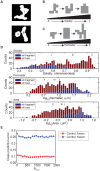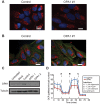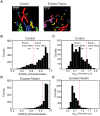Mitochondrial morphological features are associated with fission and fusion events
- PMID: 24733410
- PMCID: PMC3986258
- DOI: 10.1371/journal.pone.0095265
Mitochondrial morphological features are associated with fission and fusion events
Abstract
Mitochondria are dynamic organelles that undergo constant remodeling through the regulation of two opposing processes, mitochondrial fission and fusion. Although several key regulators and physiological stimuli have been identified to control mitochondrial fission and fusion, the role of mitochondrial morphology in the two processes remains to be determined. To address this knowledge gap, we investigated whether morphological features extracted from time-lapse live-cell images of mitochondria could be used to predict mitochondrial fate. That is, we asked if we could predict whether a mitochondrion is likely to participate in a fission or fusion event based on its current shape and local environment. Using live-cell microscopy, image analysis software, and supervised machine learning, we characterized mitochondrial dynamics with single-organelle resolution to identify features of mitochondria that are predictive of fission and fusion events. A random forest (RF) model was trained to correctly classify mitochondria poised for either fission or fusion based on a series of morphological and positional features for each organelle. Of the features we evaluated, mitochondrial perimeter positively correlated with mitochondria about to undergo a fission event. Similarly mitochondrial solidity (compact shape) positively correlated with mitochondria about to undergo a fusion event. Our results indicate that fission and fusion are positively correlated with mitochondrial morphological features; and therefore, mitochondrial fission and fusion may be influenced by the mechanical properties of mitochondrial membranes.
Conflict of interest statement
Figures






References
-
- Chan DC (2012) Fusion and fission: interlinked processes critical for mitochondrial health. Annu Rev Genet 46: 265–287. - PubMed
-
- Chan DC (2006) Mitochondria: dynamic organelles in disease, aging, and development. Cell 125: 1241–1252. - PubMed
-
- Ono T, Isobe K, Nakada K, Hayashi JI (2001) Human cells are protected from mitochondrial dysfunction by complementation of DNA products in fused mitochondria. Nat Genet 28: 272–275. - PubMed
Publication types
MeSH terms
Substances
Grants and funding
LinkOut - more resources
Full Text Sources
Other Literature Sources
Miscellaneous

